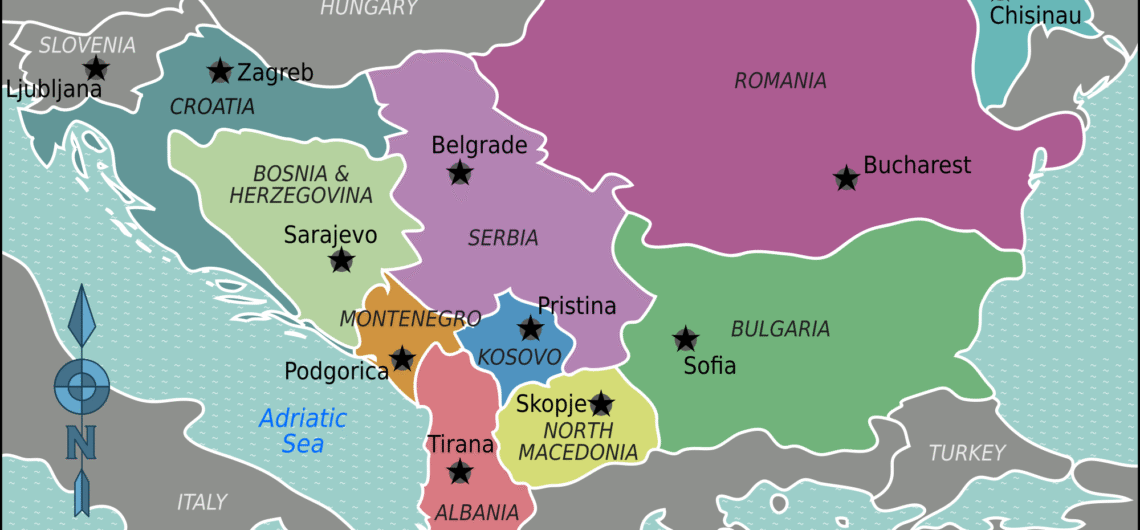So it’s come to our attention that not many people actually know where the Balkans is—or which countries are in the Balkans. To make matters more confusing, people from the Balkans can’t always agree on which countries are Balkan.
As a travel company specialising in holidays in the Balkans, we thought we should set the record straight—to the best of our abilities, it’s a tricky topic.
Where are the Balkans?
The Balkans is a block of countries in southeast Europe, stretching from Greece to Romania. There are 12 Balkan countries: Slovenia, Croatia, Bosnia and Herzegovina, Montenegro, Serbia, Albania, Kosovo, North Macedonia, Greece, Turkey, Bulgaria, and Romania.
The Balkans is a very mountainous region and its three mountain ranges – the Balkan mountains, the Dinaric Alps, and the Pindus mountains – create a natural border along with the Danube River which flows through seven Balkan states.

Some argue that Romania isn’t part of the Balkans, either due to its geographical location above the Danube or its lack of a shared history. Others say Turkey isn’t Balkan either because it’s partially in Asia. But as there are similarities with their history and culture, we’ve included both these countries too.
Related:
- Which Balkan country should I visit first?
- 10 traditional Balkan foods you have to try when you visit
- The 8 best hikes in the Balkans
What are ‘the Balkans’?
Some believe that ‘Balkan’ derives from the old Turkish word for ‘mountain.’ Others say it comes from two other Turkish words from the middle ages: ‘Bal’ meaning ‘blood’ and ‘kan’ meaning ‘honey’—because that’s what the Ottomans found when they invaded the region. The Balkans are naturally carved out by mountains and rivers, so the first definition also makes sense.
But you may be wondering other than geographical placement, what makes a country ‘Balkan’? There’s the shared history; many countries in the Balkans were famously part of the former Yugoslavia (except for Albania, Romania, Greece and Turkey). And going back further, much of the Balkans was occupied by the Ottoman empire (except for Croatia and Slovenia). For most Balkan countries, either one or both applies.

Most also share a language that has slavic roots (except for Romania, Albania and Greece), food (although they may have different names for dishes) and, of course, rakija or raki. This potent fruit brandy is drunk across the region and it’s custom to brew your own at home. If you’re offered a rakija, chances are you’re in the Balkans.
There’s also a superstition called ‘promaja’ across the region which means risking poor health or even death from a cold draft. It’s a similar concept to the British saying “catch your death.”
You will never go hungry in a Balkan country, as our guests will attest to, and in the Balkans, your home belongs to God and guests before you, so you can knock on any door and be welcomed in (most likely with a rakija).
5 myth busters about the Balkans
- Many Balkan countries aren’t actually in Eastern Europe – they’re south. Look at a map and you’ll see that Croatia, Montenegro, Albania, for example, share the Adriatic and Mediterranean seas with Spain, Greece and Portugal.
- Greece and Turkey are Balkan countries, despite common misconceptions.
- Croatia and Slovenia are Balkan, despite some locals saying they’re not. These countries lie within the geographic region and share the food, culture and history of other Balkan countries.
- The Balkans were never part of the Soviet Union, except for Bulgaria and, very briefly, Albania. General Tito insisted on an independent socialist path for Yugoslavia.
- The Balkans are not war torn and haven’t been since the 1990s. Today, you will find sublime mountainscapes, wild, untouched rivers, beautiful beaches, vibrant cities, and incredibly hospitable people.
Keen to learn more about the Balkans and travel in the region? Subscribe to our free monthly newsletter for travel inspiration, holiday offers and updates.


Comments